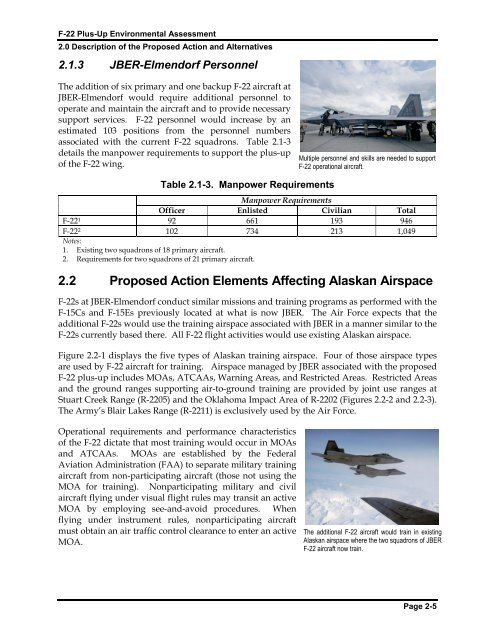F-22 Plus-Up Environmental Assessment - Joint Base Elmendorf ...
F-22 Plus-Up Environmental Assessment - Joint Base Elmendorf ...
F-22 Plus-Up Environmental Assessment - Joint Base Elmendorf ...
You also want an ePaper? Increase the reach of your titles
YUMPU automatically turns print PDFs into web optimized ePapers that Google loves.
F-<strong>22</strong> <strong>Plus</strong>-<strong>Up</strong> <strong>Environmental</strong> <strong>Assessment</strong><br />
2.0 Description of the Proposed Action and Alternatives<br />
2.1.3 JBER-<strong>Elmendorf</strong> Personnel<br />
The addition of six primary and one backup F-<strong>22</strong> aircraft at<br />
JBER-<strong>Elmendorf</strong> would require additional personnel to<br />
operate and maintain the aircraft and to provide necessary<br />
support services. F-<strong>22</strong> personnel would increase by an<br />
estimated 103 positions from the personnel numbers<br />
associated with the current F-<strong>22</strong> squadrons. Table 2.1-3<br />
details the manpower requirements to support the plus-up<br />
of the F-<strong>22</strong> wing.<br />
Multiple personnel and skills are needed to support<br />
F-<strong>22</strong> operational aircraft.<br />
Table 2.1-3. Manpower Requirements<br />
Manpower Requirements<br />
Officer Enlisted Civilian Total<br />
F-<strong>22</strong> 1 92 661 193 946<br />
F-<strong>22</strong> 2 102 734 213 1,049<br />
Notes:<br />
1. Existing two squadrons of 18 primary aircraft.<br />
2. Requirements for two squadrons of 21 primary aircraft.<br />
2.2 Proposed Action Elements Affecting Alaskan Airspace<br />
F-<strong>22</strong>s at JBER-<strong>Elmendorf</strong> conduct similar missions and training programs as performed with the<br />
F-15Cs and F-15Es previously located at what is now JBER. The Air Force expects that the<br />
additional F-<strong>22</strong>s would use the training airspace associated with JBER in a manner similar to the<br />
F-<strong>22</strong>s currently based there. All F-<strong>22</strong> flight activities would use existing Alaskan airspace.<br />
Figure 2.2-1 displays the five types of Alaskan training airspace. Four of those airspace types<br />
are used by F-<strong>22</strong> aircraft for training. Airspace managed by JBER associated with the proposed<br />
F-<strong>22</strong> plus-up includes MOAs, ATCAAs, Warning Areas, and Restricted Areas. Restricted Areas<br />
and the ground ranges supporting air-to-ground training are provided by joint use ranges at<br />
Stuart Creek Range (R-<strong>22</strong>05) and the Oklahoma Impact Area of R-<strong>22</strong>02 (Figures 2.2-2 and 2.2-3).<br />
The Army’s Blair Lakes Range (R-<strong>22</strong>11) is exclusively used by the Air Force.<br />
Operational requirements and performance characteristics<br />
of the F-<strong>22</strong> dictate that most training would occur in MOAs<br />
and ATCAAs. MOAs are established by the Federal<br />
Aviation Administration (FAA) to separate military training<br />
aircraft from non-participating aircraft (those not using the<br />
MOA for training). Nonparticipating military and civil<br />
aircraft flying under visual flight rules may transit an active<br />
MOA by employing see-and-avoid procedures. When<br />
flying under instrument rules, nonparticipating aircraft<br />
must obtain an air traffic control clearance to enter an active<br />
MOA.<br />
The additional F-<strong>22</strong> aircraft would train in existing<br />
Alaskan airspace where the two squadrons of JBER<br />
F-<strong>22</strong> aircraft now train.<br />
Page 2-5
















